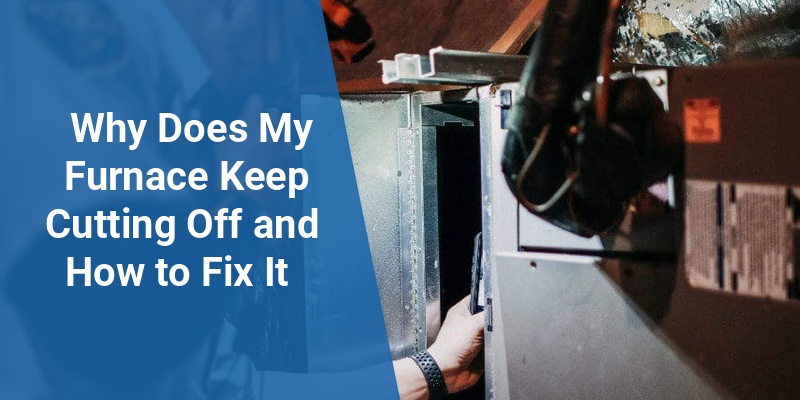Experiencing a furnace that keeps cutting off can cause discomfort and may signal underlying issues requiring timely attention. This problem affects many homeowners during colder months and can stem from various mechanical or electrical causes. Understanding the common reasons behind furnace interruptions helps maintain efficiency and extend your furnace’s lifespan.
| Common Cause | Effect on Furnace | Recommended Action |
|---|---|---|
| Dirty Air Filter | Restricted airflow, overheating | Replace or clean air filter monthly |
| Flame Sensor Issues | Fails to detect flame, shuts down system | Clean or replace flame sensor |
| Thermostat Problems | Incorrect signals causing cycles | Calibrate or replace thermostat |
| Blocked Vents or Ducts | Uneven heating, system shutoffs | Clear obstructions and inspect ducts |
| Overheating Due to Poor Airflow | Furnace safety switch triggers shutdown | Service blower motor and airflow system |
Common Reasons Your Furnace Keeps Shutting Off
A furnace shutting off repeatedly is often due to safety mechanisms preventing damage. Lack of proper airflow, sensor malfunctions, or thermostat errors frequently cause this behavior.
Dirty or Clogged Air Filter
The air filter traps dust and debris to protect your HVAC system but becomes clogged over time. Restricted airflow forces the furnace to overheat and shut off to avoid damage. Regular replacement or cleaning of filters is essential for optimal airflow.
Faulty Flame Sensor
The flame sensor ensures the furnace’s burners ignite correctly. If dirty or malfunctioning, it may incorrectly detect that the flame is out and shut the furnace down as a safety precaution. Cleaning or replacing the sensor typically resolves this issue.
Thermostat Malfunctions
The thermostat controls your furnace’s operation, but calibration errors or wiring problems can cause irregular cycling. This may result in the furnace turning off prematurely or too frequently.
Blocked or Closed Vents and Ducts
Obstructed air vents or ductwork reduce air circulation. Uneven heating and overheating trigger automatic furnace shutdowns. Ensuring all vents are open and ducts are clear supports efficient system function.
Overheating Due to Poor Airflow
Besides dirty filters, problems like blower motor failure or closed dampers can reduce airflow. This causes the furnace to overheat, activating a built-in limit switch that powers it off until it cools.
Call 888-906-9139 for Free Local HVAC Quotes – No Obligation, Just Savings!
How to Troubleshoot and Fix Furnace Cut-Off Issues
Addressing furnace shutdowns involves several diagnostic steps. Homeowners can perform basic checks, but complex repairs require professionals.
Inspect and Replace the Air Filter
Start by checking the air filter every 30 to 90 days depending on usage. Replacing a dirty filter improves airflow, reduces stress on components, and prevents overheating.
Clean the Flame Sensor
Turn off the furnace and remove the flame sensor. Use a fine abrasive pad or steel wool to gently clean the sensor’s metal rod. This restores accurate flame detection and reduces shutdowns.
Check the Thermostat
Confirm thermostat settings match home comfort needs. Replace batteries if applicable and consider recalibrating or upgrading to a digital model for more precise control.
Open and Clear All Vents
Ensure all vents in each room are open and unblocked by furniture or debris. If needed, hire a technician to inspect ductwork for blockages or leaks.
Examine the Blower Motor
Listen for unusual noises or weak airflow which may indicate blower motor issues. Maintenance or replacement by an HVAC technician can restore proper airflow and prevent overheating.
When to Call a Professional HVAC Technician
While routine maintenance is key, persistent furnace cut-offs require expert diagnosis. Complex electrical faults, gas valve malfunctions, or pilot light problems must be handled by licensed professionals. Regular annual servicing can preempt costly failures.
Call 888-906-9139 for Free Local HVAC Quotes – No Obligation, Just Savings!
Preventative Tips to Keep Your Furnace Running Smoothly
- Schedule Annual Maintenance: Professional inspection detects wear and improves efficiency.
- Change Air Filters Regularly: Follow manufacturer guidelines based on usage and environment.
- Monitor Thermostat Performance: Replace outdated units for consistent temperature control.
- Keep Air Vents Unobstructed: Clear furniture and clean around vents to promote airflow.
- Inspect Pilot and Flame Sensors: Clean as needed to ensure proper ignition.
Impact of Furnace Cutting Off on Home Comfort and Energy Bills
Frequent furnace shutdowns not only reduce home comfort but also increase energy consumption. Repeated cycles cause inefficient heating, driving up utility bills. Proper maintenance and timely repairs ensure steady warmth and energy savings.
Understanding Furnace Safety Features Related to Cut-Offs
Modern furnaces include safety mechanisms like limit switches and flame sensors designed to prevent overheating, gas leaks, and fire hazards. While inconvenient, these cut-offs protect your home and HVAC system from damage.
How Energy Efficiency Affects Furnace Operation
Older, inefficient furnaces often have increased mechanical issues leading to frequent shutdowns. Upgrading to high-efficiency models with electronic controls reduces cut-offs and lowers energy usage.
